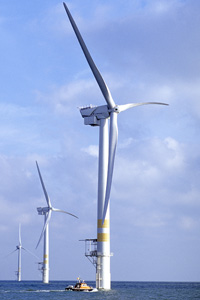
A 500 MW wind farm with the power to supply clean electricity to over 415,000 homes, more than all the demand in Suffolk, was approved for construction last week. The project is being developed by Airtricity and Fluor. Comprised of 140-turbines the project will cut CO2 emissions by 1.5 million tonnes a year – the equivalent of taking 350,000 cars off the road.
Airtricity, one of Europe’s leading renewable energy companies, together with its joint venture partner Fluor, has been awarded a lease from The Crown Estate to build and operate the offshore wind park at Greater Gabbard in the United Kingdom.
The award of the lease to the Airtricity/Fluor joint venture is part of the second round competition for UK offshore wind farm developments by The Crown Estate. The sites available for offshore wind farm development are located in the three strategic areas announced by the Secretary of State for Trade and Industry in July 2003: the Thames Estuary, the Greater Wash and the North West (Liverpool Bay).
On December 18 2003 The Crown Estate announced the award of lease option agreements to 12 successful bidders for the development of offshore wind farms. The successful developers will be required to obtain all statutory planning consents from the government to allow construction to take place.
Airtricity have built wind projects in the UK before, including the Arklow Bank project in the Irish Sea, the first phase of which is already constructed through a co-development agreement with GE. Fluor’s role, once all permitting and financing has been secured, would be to provide the engineering, procurement and construction for the project.
The Greater Gabbard Project is located approx. 26 km from the Suffolk coast and comprises one site located in the outer Thames Estuary on two sand banks known as the Inner Gabbard and The Galloper. It is regarded as an ideal site for an offshore wind farm due to high wind speeds, low water depth, suitable ground conditions and minimal environmental sensitivities.
Airtricity/Fluor will immediately initiate an environmental impact assessment study, which will take approximately 15 months to complete. My experience with the Cape Wind project makes me envious of a 15 month process. It has been over three years since Cape Wind has applied for approval of its project. This new wind project will most likely be approved and built in less than three years.
On completion of the environmental impact assessment, and following the successful acquisition of all permits, construction of the wind farm will commence. Commenting on winning the lease, Eddie O’Connor, Airtricity’s Chief Executive said, “Airtricity and Fluor are delighted to be playing such a significant part in the development part of offshore wind energy in the UK. Together we will assist the UK Government to meet its commitment of 10 percent of UK electricity being derived from renewable sources by 2010. Awarding of this project confirms that Airtricity is a world leader in renewable energy, and we look forward to moving this development to the next stage. â€
Patrick Flaherty, a Fluor senior vice president, said: “We are very pleased to have received this important award from the Crown Estate for the Greater Gabbard Offshore wind farm Development. Our partnership with Airtricity effectively combines the knowledge of the renewable energy business with the skills of permitting, financing, and constructing wind energy and large-scale offshore projects. Fluor and Airtricity are committed to making this project a success for all stakeholders.â€
This is a great start- however the reality is that at at palnning stage the process is being undermined from both ends- firstly it is very difficult to get permission for sizable renewable plants, secondly he crucial infratsructure linking sites- in Scotland for example, to the rest of teh country where the power is needed is also blocked
see quotes below
The British Wind Energy Association (BWEA) said 12 out of 18 proposals had failed to win planning consent. This will make it difficult for the UK to meet its current target of generating 10% of electricity from renewables by 2010 – not to mention the ambitious target of 20% that Mr Blair has now decided Britain must reach.
As BWEA CEO Maria McCaffery commented:
“The planning process has been a thorn in the side of the UK wind industry as we strive to meet the Government’s 10% renewable energy target by 2010. We have proven as an industry that we can deliver on a large scale, here and now, but this momentum can only be maintained with more timely and consistent decision making in the UK. The new focus on climate change must be adopted as quickly as possible at all levels of Government and across all regions in the UK. Climate change is now at the top of the public agenda – it is time for governments to respond with more resource, commitment and monitoring and enforcement of the planning system to better reflect the urgency of action needed.”
Peter: We too have permitting problems in the US. At least the UK seems to have developed a framework to permit these farms. Its been almost 6 years since the Cape Wind project was proposed and it still is yet to be approved or denied.
I would hope that some day the process of siting and constructing these projects becomes smooth and quick. Thanks for the comment.